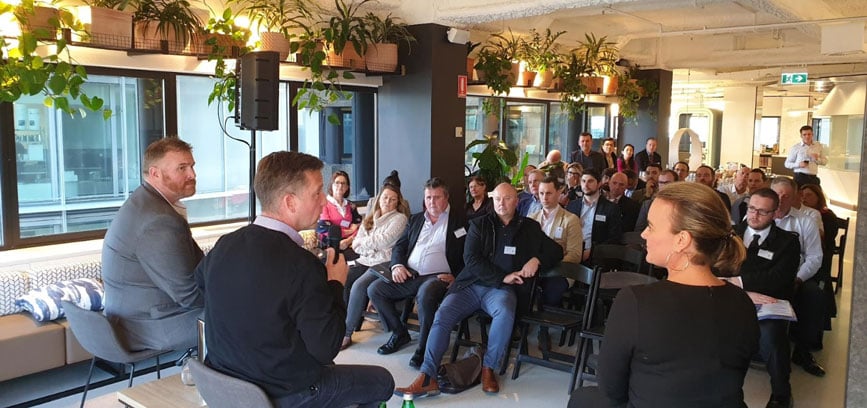How technology drives workplace transformation (Part 2 of 2)
According to a recent research report by Deloitte, the office is not getting any smaller or going away anytime soon, even with advances in mobile and digital technologies. In fact, from 1990 to 2017, the amount of total available office floor space in Australia even grew by 60%.
Technology is definitely transforming the workplace and how people work – but not the way most people think. Robots won’t be replacing everyone’s jobs. Deloitte mentions that people will still be ‘central to the future of work.’ What will change is the types of work humans do and the skills needed to succeed in the future.
At a lunch-and-learn event, we covered how technology drives workplace transformation. In this post, we go deeper into the discussion and focus on the impact of technology on the way people work:
Regarding the use of meeting rooms, how do you give people a choice when it comes to physical space and being able to duck into a room without the need to book?
- Help employees to be more productive. People don’t come to the office because they want to. They come to the office to simply do their work and be productive. Employees ask themselves: ‘What’s in it for me?’ Things like meeting rooms and booking services need to help employees navigate obstacles and do their jobs effectively.
- Provide an on-demand and personalised experience. It’s about giving your staff what they want, when they need it and in a form that is very personalised to them. They have to be able to identify with the experience and see its value. Take the example of the Uber experience. The service is not the vehicle or the driver. A normal taxi can provide that. The real difference that Uber offers is the ability to provide on-demand services, whenever and wherever they’re needed. Once you give people the confidence in choosing a meeting experience from anywhere at any time, you will see a change in behaviour. The work environment is no longer a big deal, and you will see a significant increase in workplace efficiency. We can create variety and choice across the whole environment that permits them to basically operate from anywhere but it’s underpinned by that confidence model.
When should you start considering technology when planning an office move or redevelopment?
You need to start thinking of how technology can be integrated as early as possible. According to Dan, you have to consider technology in the early stages of the process and “talk about technology today as a scalable investment.”
During an office move or refurbishment, people usually focus on where the space is going to be and what it’s going to look like. They defer technology decisions towards the end of the project – when budgets and timeframes are already constrained. This results in making some significant sacrifices on the technology front. They start cutting down on the things they wanted at the beginning. And they end up letting down the people who are going to use that work environment, ultimately impacting the level of potential productivity that could be leveraged.
So, don’t make the same mistake. Start to think about technology as a platform approach and identify and invest in what you need early.
Also, by thinking about technology early and properly communicating your needs to providers and partners, the better off you will be in meeting expectations and deadlines and achieving the outcomes you wanted at the beginning.
What is the behavioural impact of enabling technology in the way people operate, such as working from home or working non-traditional hours?
Technology has such a significant impact on the workplace, that it is changing the way people work. Here are some insights from our panel of experts:
People still seek human connection
With advances in mobile and digital technologies, people are now able to work anytime, anywhere. These days, people have the freedom and flexibility to work from home and outside the normal 9-5 hours.
But it seems employees still look for human connection. There is a slow shift back to people wanting to work in the office. They like meeting face-to face, looking people in the eye, shaking hands and directly engaging with colleagues and customers. Some even think that they are more productive and effective when working side-by-side with their team in the office.
Work-life harmony
Let's call it “work-life harmony” rather than balance as we all have to go to work and go home at the end of the day. Both work and home life are intertwined but it’s the communication piece in the middle that enables us to connect with our families and colleagues. Nothing can replace the element of human connection.
That’s why companies like Axiom develop workplaces that enhance human experiences and implement technology that enables harmony between work and home life – encouraging people to come back to the office. This then creates a cultural shift attracting employees of all levels, including leadership, to come in and get the work done.
Personalised service
Why would someone come to this office? As an employee, why would I want to do this? What’s in it for them? These are some of the questions that you need to consider when building workplace environments.
It’s not just about how impressive the technology is that you want to integrate. It also needs to serve a purpose. People need to see and experience the value of the service. Plus, it needs to be personalised to each individual’s need. For every inconvenience, we need to give employees two conveniences so they can start to offset one another, and they can start to see the value proposition beyond the friction.
Technology won’t be able to solve everything. There are going to be certain problems that you’re never going to be able to overcome or be able to rectify, but if you start to add lots of little things people can identify with – then they will begin to see the overall value of what you’re trying to do.
So, don’t just give your employees a desk to work on, personalise the service and make things easier for them. This would not only increase employee job satisfaction but also improve productivity and efficiency in the workplace.
This is how it all comes together; you’ve got to treat the working environment with respect and your employees with respect.
Want to learn how a design partner can help implement the right technologies to create a more productive and engaging workplace for your employees? Check out our free ebook How to choose a workplace design partner. Download it now!






